
Thebit is a lunar impact crater located on the southeast shore of Mare Nubium. To the north-northwest is the crater Arzachel, and Purbach lies to the south-southwest. To the southwest is the flooded remnants of Thebit P, which is actually larger in diameter than Thebit itself.

Bayer is a lunar impact crater located in the southwest section of the moon, to the east of the crater Schiller. The rim of Bayer is slightly worn by erosion, but remains well-defined. There is an inner terrace, but the outer wall is intruded upon by nearby impacts. The most significant of these is Schiller H, which forms a ridge attached to the northwest rim of Bayer. The floor of Bayer is relatively flat and lacks a central peak. There is a small, but notable crater on the floor near the western wall. This crater has a breach in its northern rim.

Birt is a lunar impact crater located in the eastern half of the Mare Nubium and west of the Rupes Recta. It was named after British selenographer William R. Birt.
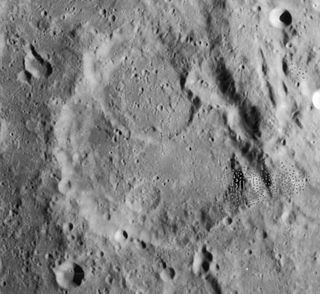
Catharina is an ancient lunar impact crater located in the southern highlands. It was named after Saint Catherine of Alexandria. It lies in a rugged stretch of land between the Rupes Altai scarp to the west and Mare Nectaris in the east. To the west-northwest is the crater Tacitus, and the lava-flooded Beaumont lies to the east along the shore of Mare Nectaris. To the south-southeast is Polybius.

Cauchy is a small lunar impact crater on the eastern Mare Tranquillitatis. It was named after French mathematician Augustin-Louis Cauchy. It is circular and symmetric, with a small interior floor at the midpoint of the sloping inner walls. Due to the high albedo of this bowl-shaped formation, it is particularly prominent at full Moon.

Chladni is a small lunar impact crater that lies near the northwest edge of Sinus Medii, in the central part of the Moon. The crater is named for German physicist and musician Ernst Chladni who, in 1794, wrote the first book on meteorites. The rim of the crater is roughly circular, and there is a small central floor at the midpoint of the sloping inner walls. This feature has a higher albedo than the surrounding terrain. It is connected by a low ridge to the rim of the crater Murchison, which lies to the northwest. Due east of Chladni is the larger Triesnecker.

Polybius is a lunar impact crater in the southeast part of the Moon, and is named after ancient Greek historian Polybius. It is located to the south-southeast of the larger crater Catharina, in the area framed by the Rupes Altai scarp. Some distance to the northeast is the Mare Nectaris, with the flooded craters Beaumont and Fracastorius.

Letronne is the lava-flooded remnant of a lunar impact crater. It was named after French archaeologist Jean-Antoine Letronne. The northern part of the rim is completely missing, and opens into the Oceanus Procellarum, forming a bay along the southwestern shore. The formation is located to the northwest of the large crater Gassendi.To the west-southwest is the flooded crater Billy, and north-northwest lies the smaller Flamsteed.

Purbach is a large lunar impact crater located in the rugged southern highlands of the Moon. The distorted crater Regiomontanus is attached to the southern rim. To the northwest is Thebit and just to the northeast lies La Caille.

Sacrobosco is an irregular lunar impact crater that is located in the rugged southern highlands to the west of the Rupes Altai escarpment. It is a readily identified feature due to the three circular craters that lie on its floor. The rim of Sacrobosco is heavily worn and eroded, especially in the northeast. The floor is relatively flat in the south, except where overlain by Sacrobosco A and B, but is somewhat irregular in the northeast.
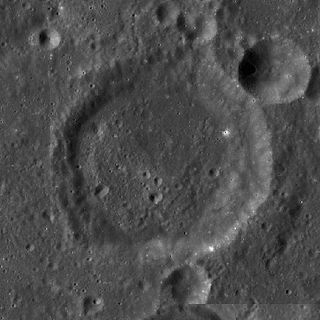
Almanon is a lunar impact crater that lies in the rugged highlands in the south-central region of the Moon. It was named after Abbasid Caliph and astronomer Al-Ma'mun. It is located to the south-southeast of Abulfeda, and to the north-northeast of the smaller crater Geber. The crater chain designated Catena Abulfeda forms a line between the south rim of Abulfeda and the north rim of Almanon, continuing for a length of about 210 kilometers to the Rupes Altai scarp.

Pons is a lunar impact crater that is located to the west of the prominent Rupes Altai scarp. It was named after French astronomer Jean-Louis Pons. It lies to the southeast of the crater Sacrobosco, and southwest of Polybius. To the northwest along the same flank of the formation is the crater Fermat.
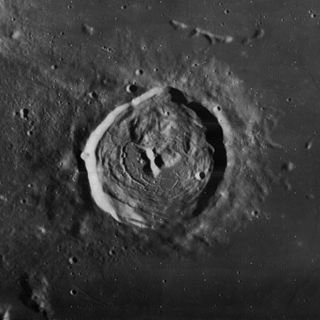
Briggs is a lunar impact crater that is located in the western part of the Oceanus Procellarum, to the east of the large walled plain Struve. It lies to the northeast of the walled plain Eddington, and north-northwest of the crater Seleucus. The isolated position of this crater on the mare, near the northwestern limb of the Moon, makes it relatively easy for an Earth-bound observer to locate. The crater is named after the English mathematician Henry Briggs.

da Vinci is a lunar impact crater that is located in the eastern part of the Moon, to the northwest of Mare Fecunditatis. It lies along the eastern shore of the Sinus Concordiae, a bay along the eastern edge of Mare Tranquillitatis. Nearby craters include Watts to the southeast and Lawrence to the southwest, both smaller in dimension than da Vinci.
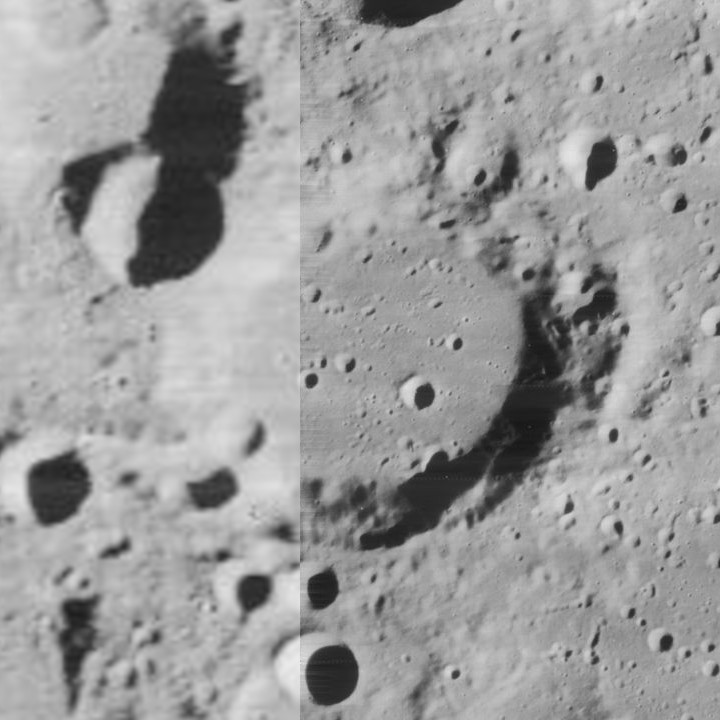
Cleostratus is a lunar impact crater near the northwest limb of the Moon. It lies to the northeast of the crater Xenophanes, and west-southwest of the prominent Pythagoras. From the Earth this crater appears highly elongated due to foreshortening.

Chauvenet is a lunar impact crater that is located to the northeast of the prominent crater Tsiolkovskiy on the far side of the Moon. Less than one crater diameter to the northwest of Chauvenet is the crater Ten Bruggencate.

Congreve is a lunar impact crater that is located on the far side of the Moon relative to the Earth, and lies across the lunar equator. It lies to the west-northwest of the massive walled plain Korolev. To the southeast is the crater Icarus, and due north is Zhukovskiy.

Rothmann is an impact crater that is located in the southeastern part of the Moon's near side, about one crater diameter to the southwest of the Rupes Altai scarp. To the southwest is the slightly larger crater Lindenau.

Diderot is a small lunar impact crater on the far side of the Moon. It lies within the southwestern interior floor of the huge walled plain Fermi, about midway between the basin midpoint and the southwest rim. The crater is saucer-shaped, with smaller craters located just to the northwest and the north. The inner wall is narrower along the eastern side, and has a pair of ridges along the southern face. This crater is otherwise unremarkable.
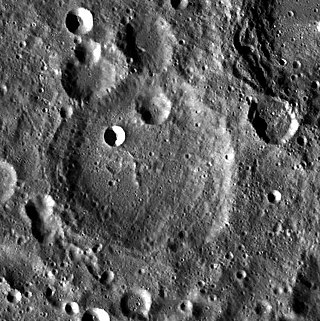
Kurchatov is a lunar impact crater that is located on the Moon's far side. It is just to the southwest of the crater Wiener, and farther to the southeast of Bridgman. A couple of crater diameters to the south of Kurchatov is the northern edge of the Mare Moscoviense.























